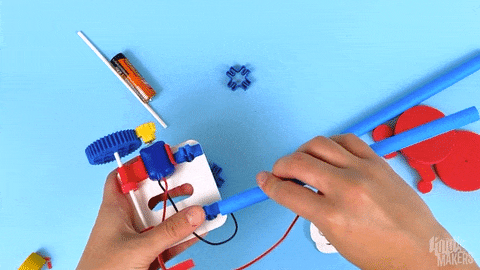Log in for educator slides and coaching guides.
Log InLinkages
Like this product? Add it to your favorites list
(accessible from your profile page)
(accessible from your profile page)
Build moving creatures and mechanisms with systems of sturdy cardboard levers and pivots. Create animals that dance, fish that swim and other creatures that come to life! Grow dexterity, persistence, experimentation and critical thinking skills.
Suggested Grade Levels
PK - 5
You Provide:
Everything's in the Spark!
Suggested Activity Station Time
15 min
Recommended Classroom Learning Time
40 min
Here's everything you'll need to coach with confidence!
Coaching Guide
Resources
Standards Alignment
Features
CASEL Skills
No items found.
Math Common State Standards
- Fluently add and subtract within 5
- Describe objects in the environment using names of shapes, and describe the relative positions of these objects using terms such as above, below, beside, in front of, behind, and next to.
- Analyze and compare two- and three-dimensional shapes, in different sizes and orientations, using informal language to describe their similarities, differences, parts (e.g., number of sides and vertices/“corners”) and other attributes (e.g., having sides of equal length).
- Distinguish between defining attributes (e.g., triangles are closed and three-sided) versus non-defining attributes (e.g., color, orientation, overall size); build and draw shapes to possess defining attributes.
- Recognize and draw shapes having specified attributes, such as a given number of angles or a given number of equal faces.5 Identify triangles, quadrilaterals, pentagons, hexagons, and cubes.
- Understand that shapes in different categories (e.g., rhombuses, rectangles, and others) may share attributes (e.g., having four sides), and that the shared attributes can define a larger category (e.g., quadrilaterals). Recognize rhombuses, rectangles, and squares as examples of quadrilaterals, and draw examples of quadrilaterals that do not belong to any of these subcategories.
- Recognize a line of symmetry for a two-dimensional figure as a line across the figure such that the figure can be folded along the line into matching parts. Identify line-symmetric figures and draw lines of symmetry.
- Classify two-dimensional figures in a hierarchy based on properties.
NGSS Standards
K-PS2-1
1-LS1-1
2-PS1-3
3-PS2-2
3-5-ETS1-3
Structure and Function
ELA Common State Standards
- With prompting and support, ask and answer questions about unknown words in a text.
- Ask and answer questions to help determine or clarify the meaning of words and phrases in a text.
- Know and use various text features (e.g.,captions, bold print, subheadings, glossaries,indexes, electronic menus, icons) to locate key facts or information in a text efficiently.
- Use text features and search tools (e.g., key words, sidebars, hyperlinks) to locate information relevant to a given topic efficiently.
- Interpret information presented visually, orally, or quantitatively (e.g., in charts, graphs, diagrams, time lines, animations, or interactive elements on Web pages) and explain how the information contributes to an understanding of the text in which it appears.
- Quote accurately from a text when explaining what the text says explicitly and when drawing inferences from the text
- Understand that words are separated by spaces in print.
- Know and apply grade-level phonics and word analysis skills in decoding words.
- Use context to confirm or self-correct word recognition and understanding, rereading as necessary.
- Participate in collaborative conversations with diverse partners about kindergarten topics and texts with peers and adults in small and larger groups.
- Build on others’ talk in conversations by responding to the comments of others through multiple exchanges
- Recount or describe key ideas or details from a text read aloud or information presented orally or through other media.
- Ask and answer questions about information from a speaker, offering appropriate elaboration and detail.
- Engage effectively in a range of collaborative discussions (one-on-one, in groups, and teacher- led) with diverse partners on grade 4 topics and texts, building on others’ ideas and expressing their own clearly
- Pose and respond to specific questions by making comments that contribute to the discussion and elaborate on the remarks of others























